IC1805, IC1848 and Double Cluster region in HOO, RGB stars
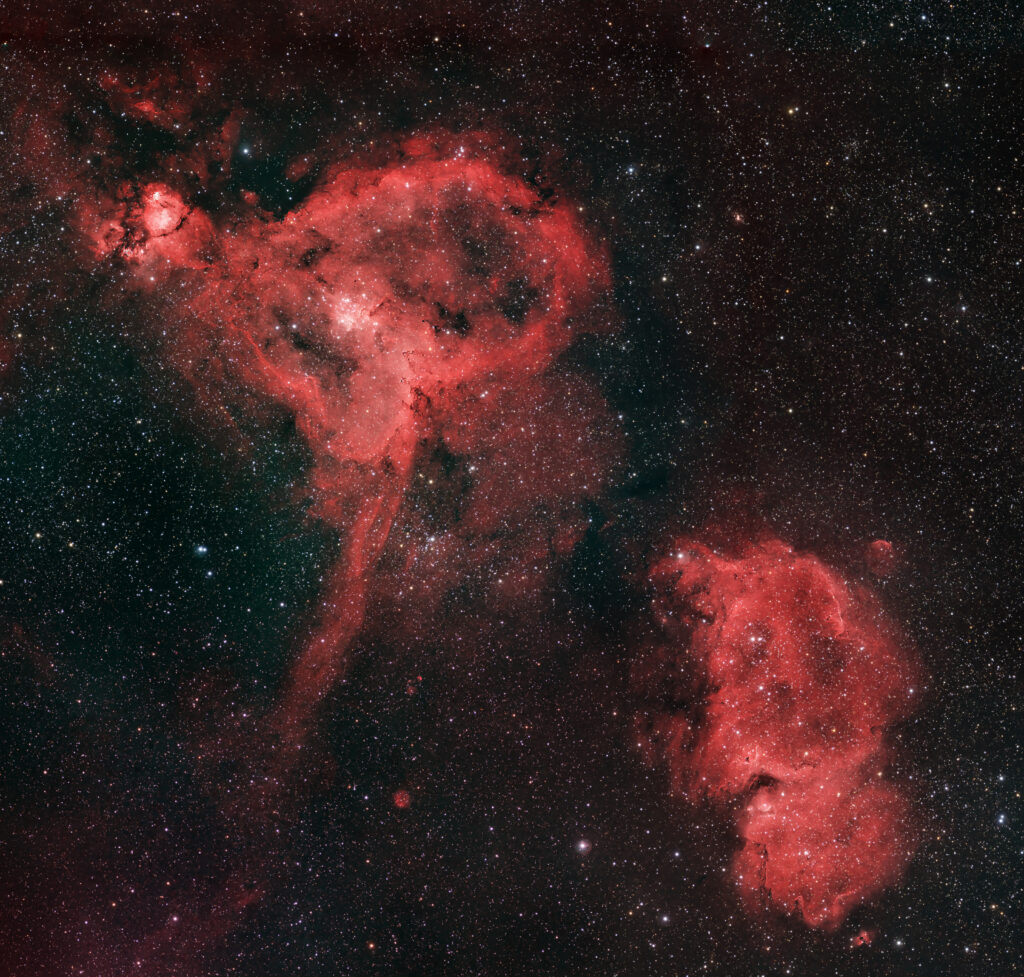
Mosaic made by 9 panels, with starless master in narrowband, HOO palette, and stars integration in RGB.
Narrowband subframes of 180″, 300″ and 600″, RGB subframes at 60″ exposure.
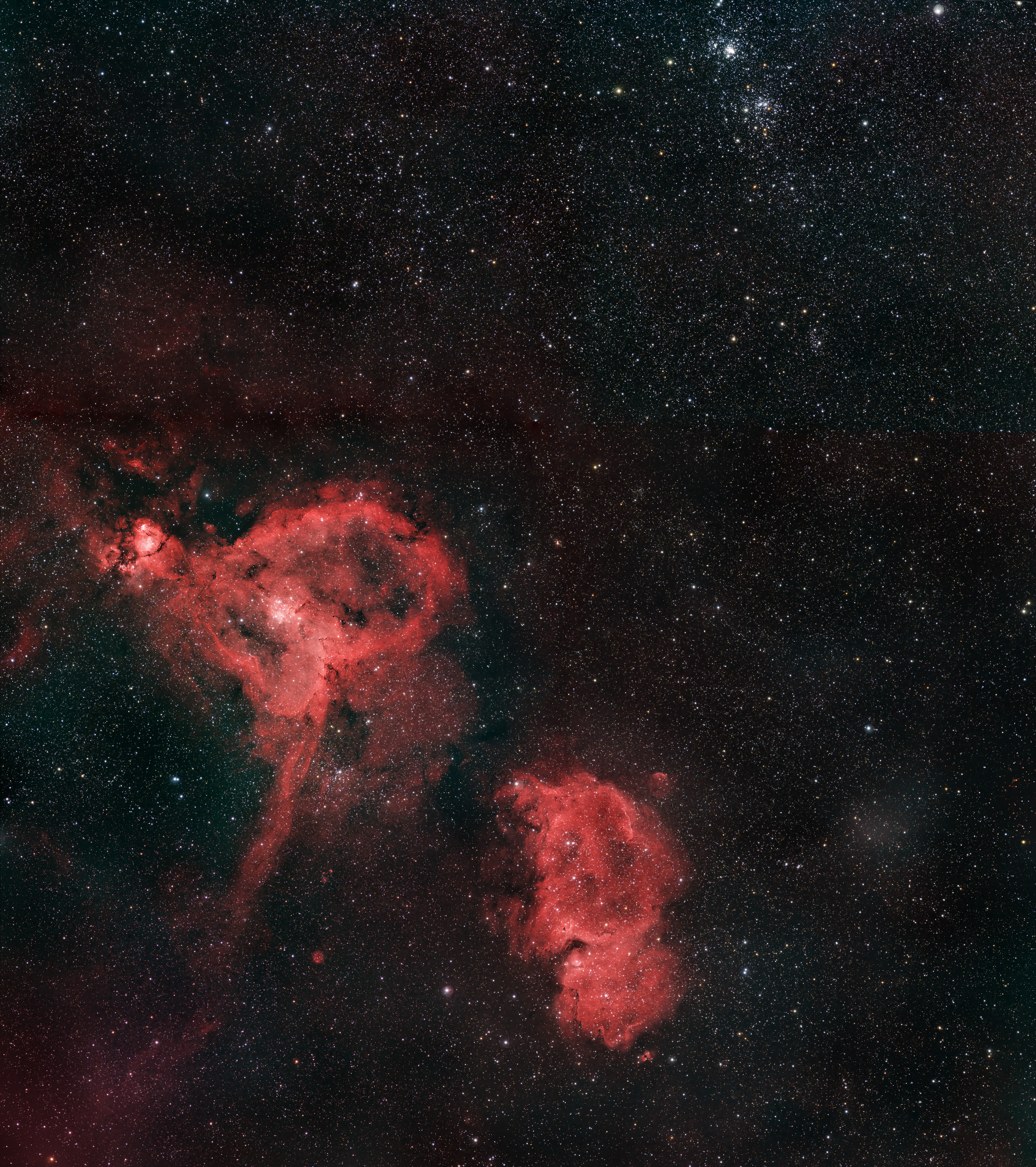

Mosaic made by 9 panels, with starless master in narrowband, HOO palette, and stars integration in RGB.
Narrowband subframes of 180″, 300″ and 600″, RGB subframes at 60″ exposure.

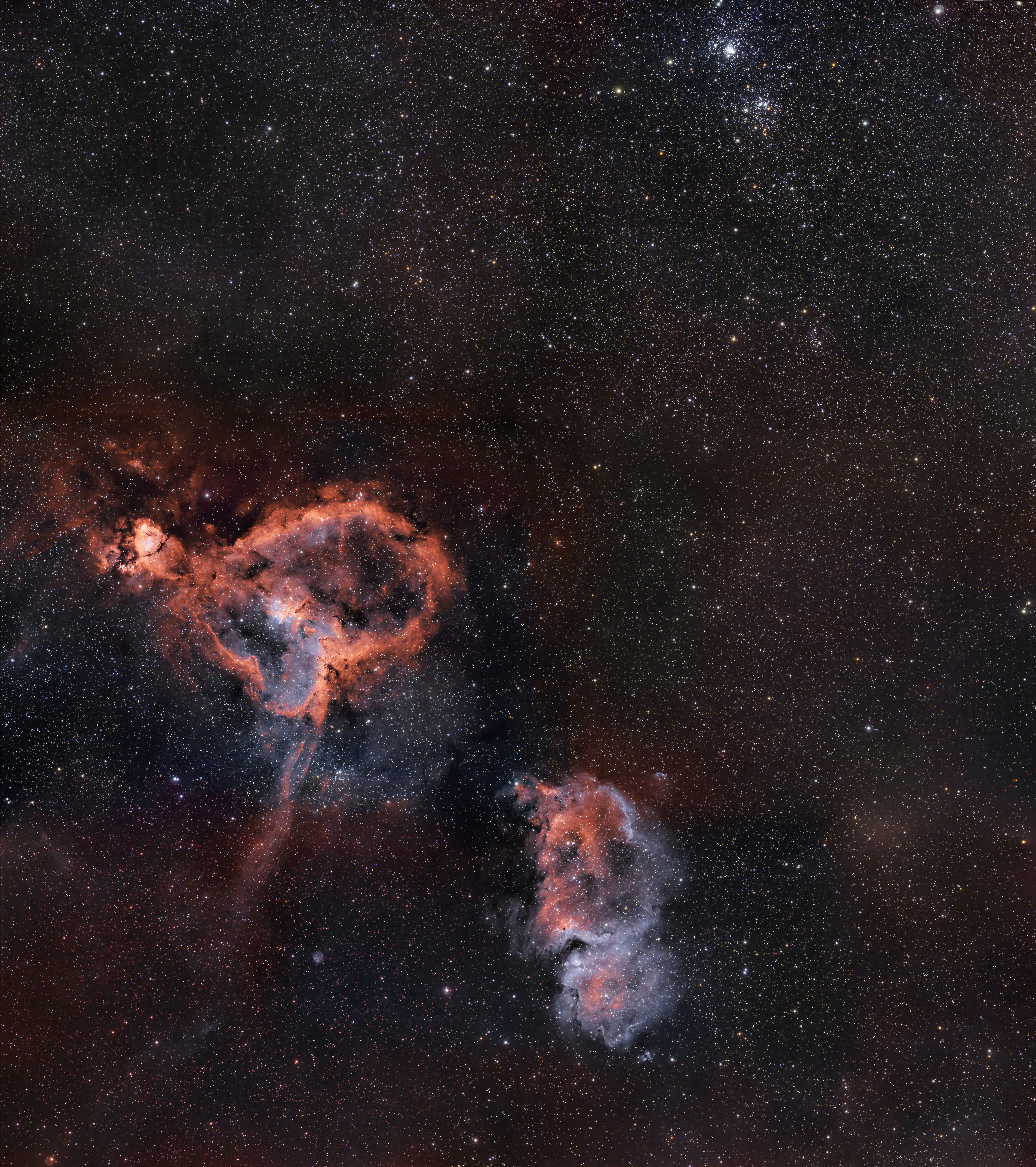
Mosaic made by 9 panels, with starless master in narrowband, SHO palette, and stars integration in RGB.
Narrowband subframes of 180″, 300″ and 600″, RGB subframes at 60″ exposure.
Astrobin:
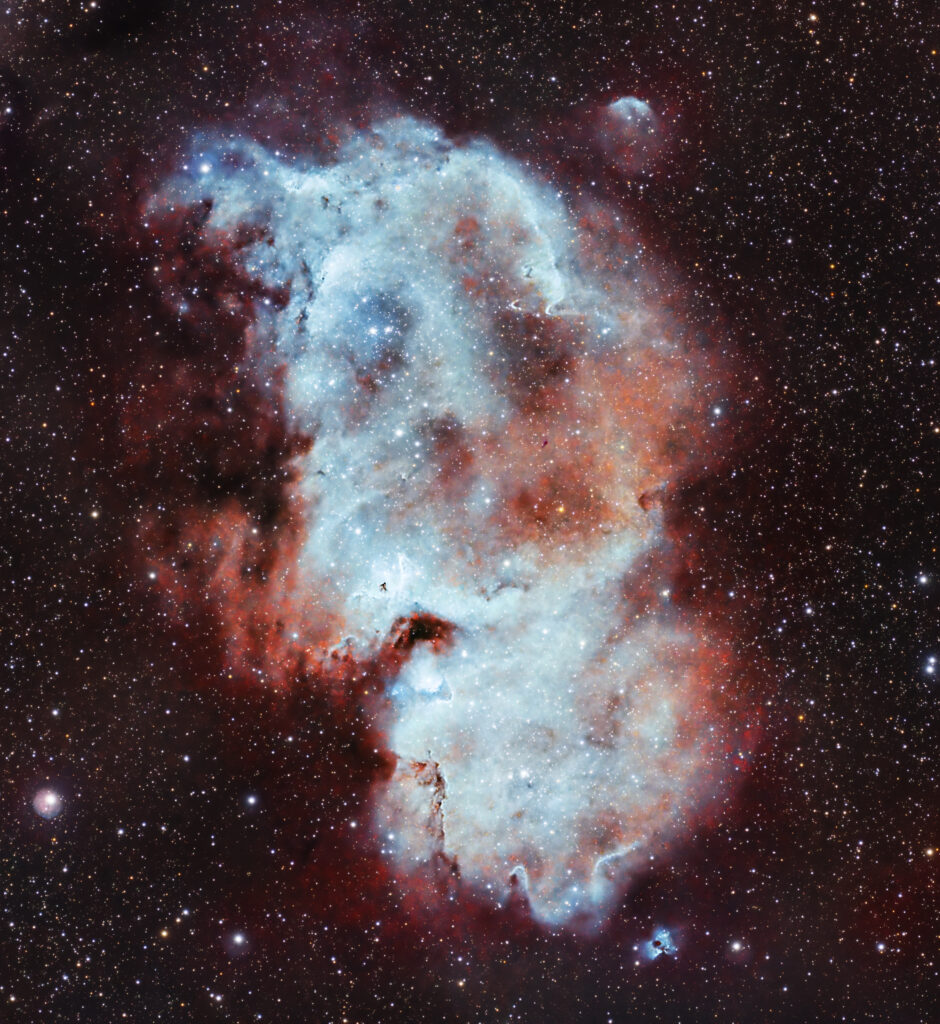
IC1848 in narrowband, with stars in RGB. SHO palette and cropped field to best focusing about Soul Nebula IC1848.
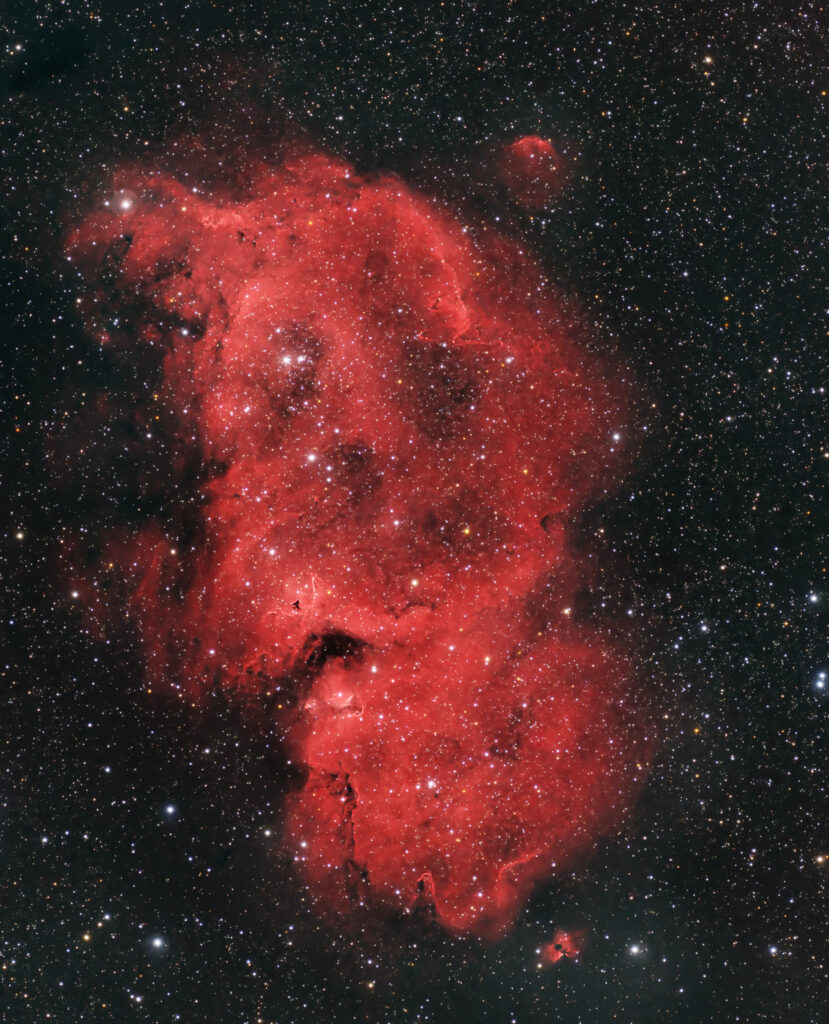
HOO palette and RGB stars
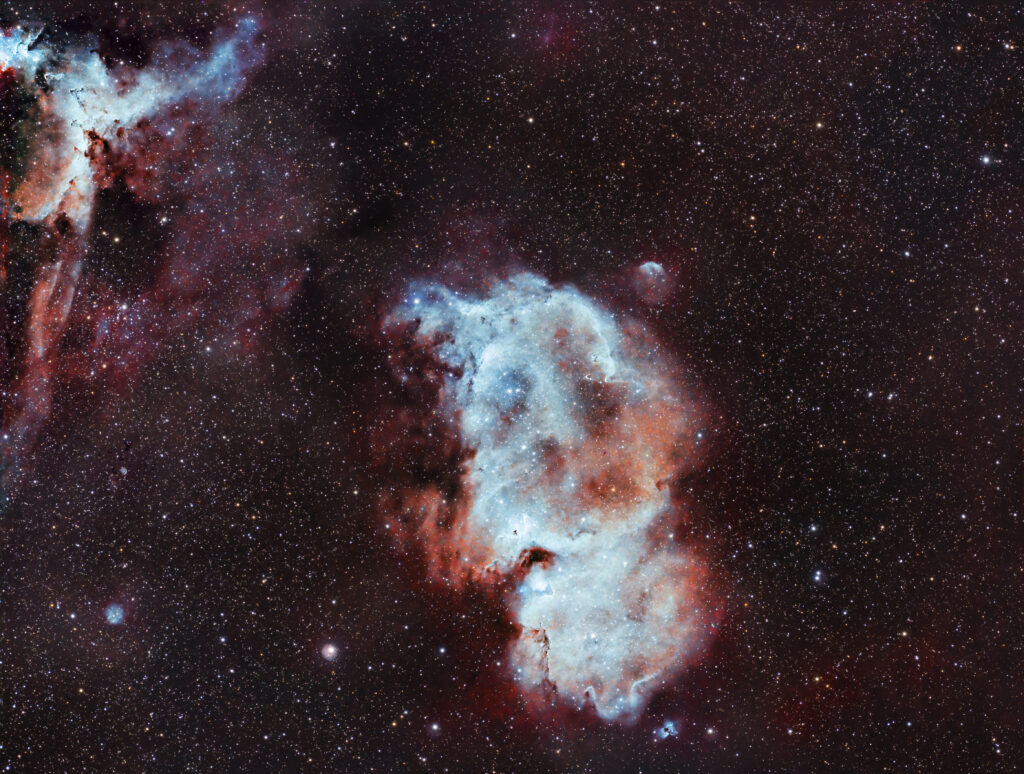
Wider field from original integration, with part of IC1805 on the top left
Astrobin:
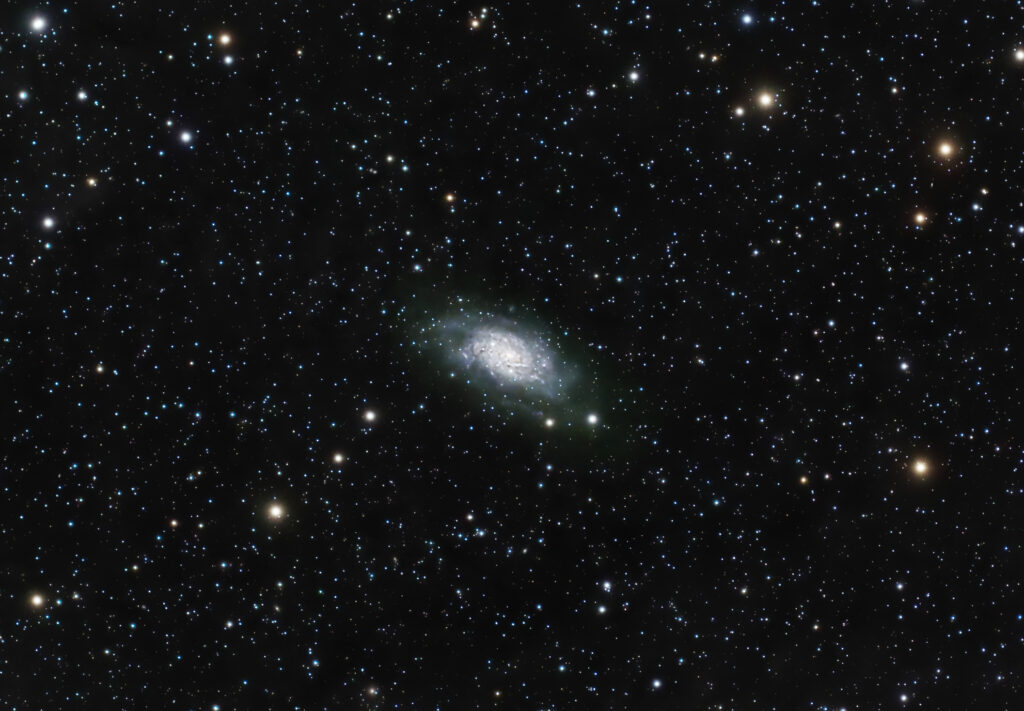
NGC2403 Galaxy in RGB. William Optics Redcat 51 and ASI1600mm Pro, 60 seconds LRGB subframes taken at -20C between 10/09/2022 and 13/02/2023, suburban 6 Bortle scale sky (Livorno – IT).
Final image is the 2nd cropped version from the wider range integration
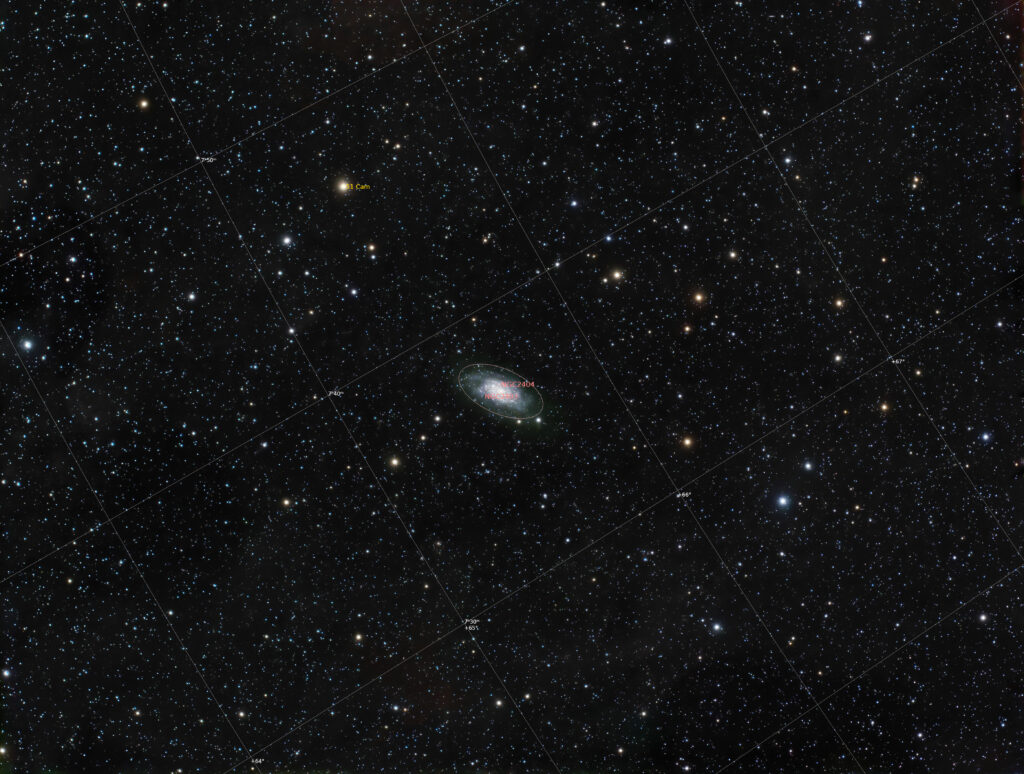
Less incisive cropping as first attempt to get more focusing about NGC2403
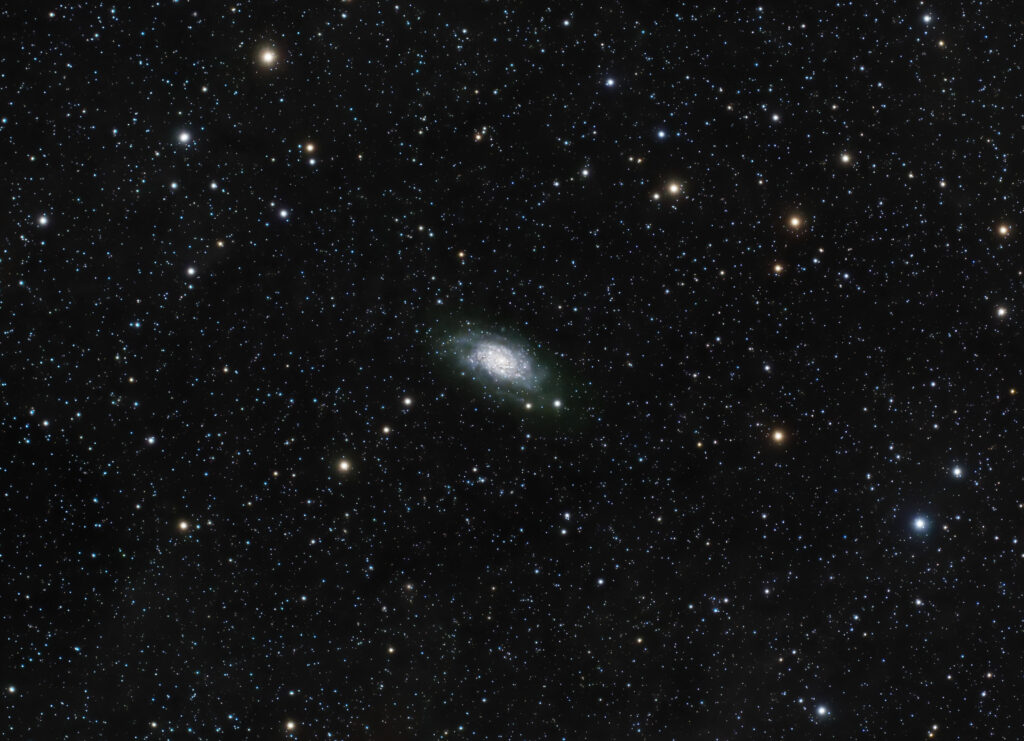
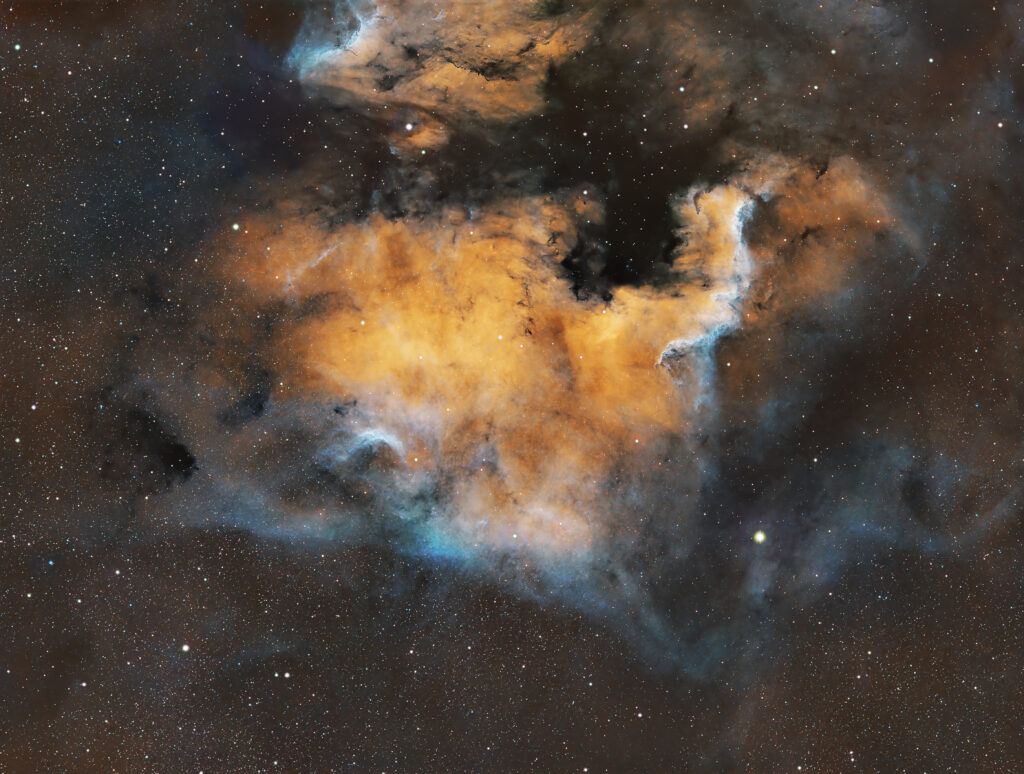
Cygnus NGC7000 region in narrowband, with Hbeta records as integration of Oiii emission for Blue channel.
Astrobin: https://www.astrobin.com/76k369/
This is the second of a 2 panel mosaic focused about this region of Cygnus, so rich and beautiful! Subframes recorded between 27/05/2023 and 12/09/2023 with William Optics Redcat 51 and ASI1600mm Pro, at -20C, gain 173 and 180sec of exposition; some subframes at 300sec expecially for Halpha channel help in faint nebulosity detail emerging.
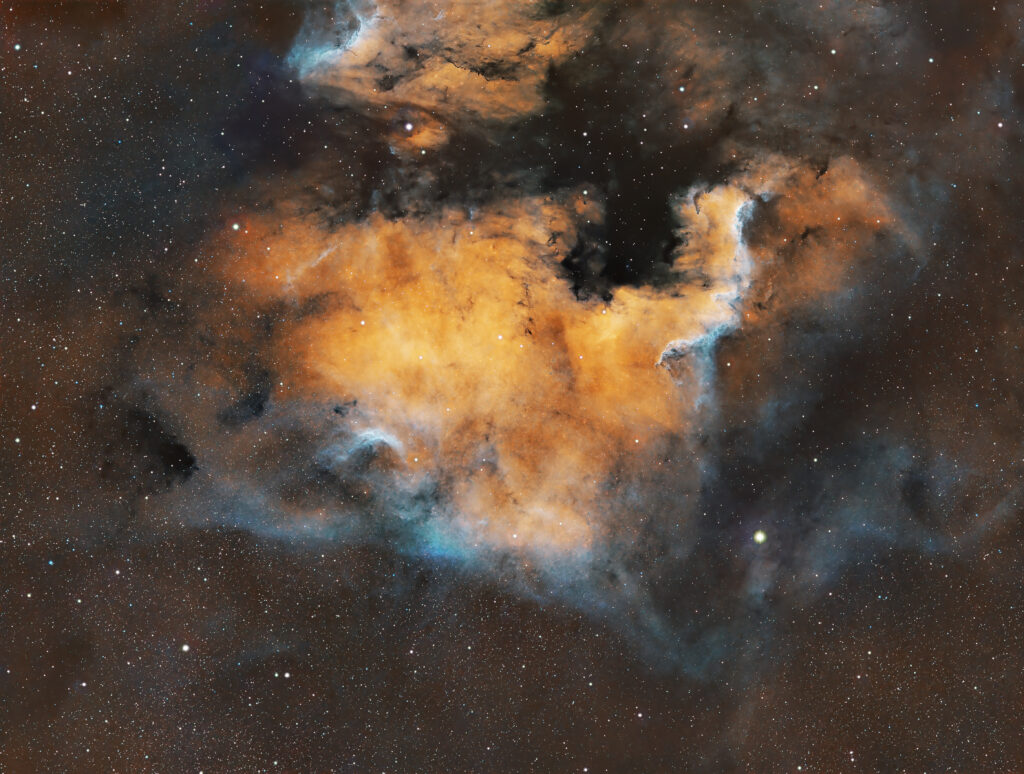
Typical SHO palette
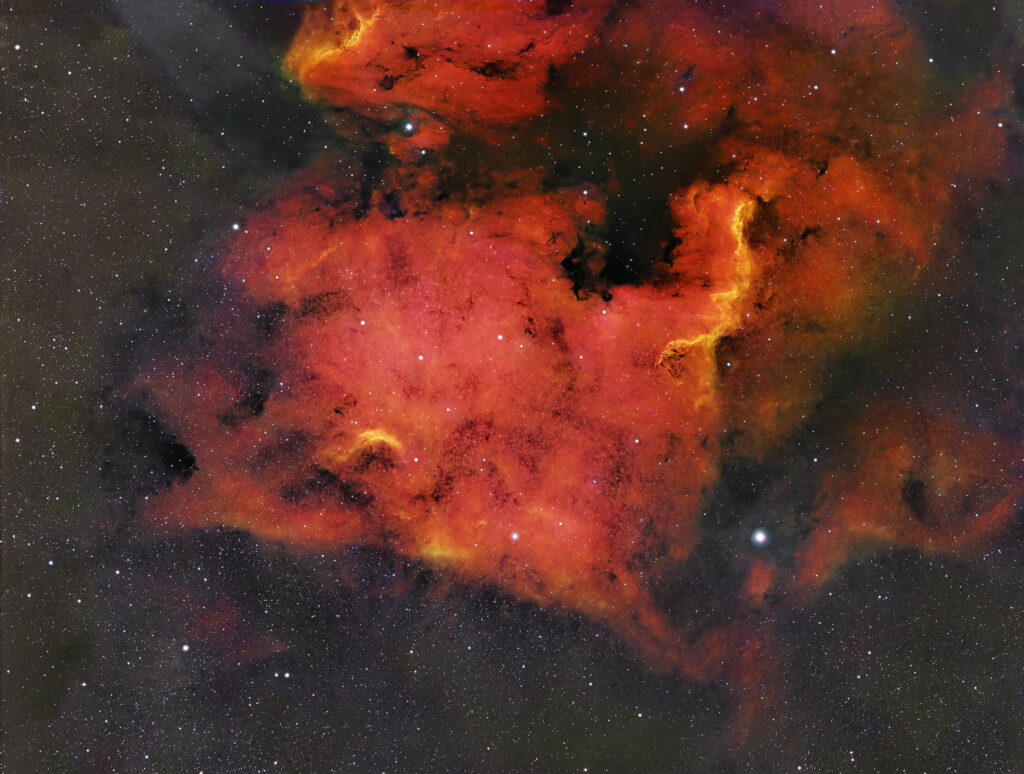
Ha Oiii and Hbeta palette integration
Photoshop master with layers group and adjustement vailable here: https://e.pcloud.link/publink/show?code=XZ9NXsZo1uiGtOAUqjyYRcfYkusnFHgzGnV
Framelist (Astrobin CSV preformatted) available here: https://e.pcloud.link/publink/show?code=XZdNXsZg65lchLciqBcYOw5sGYQkY9gXpWk
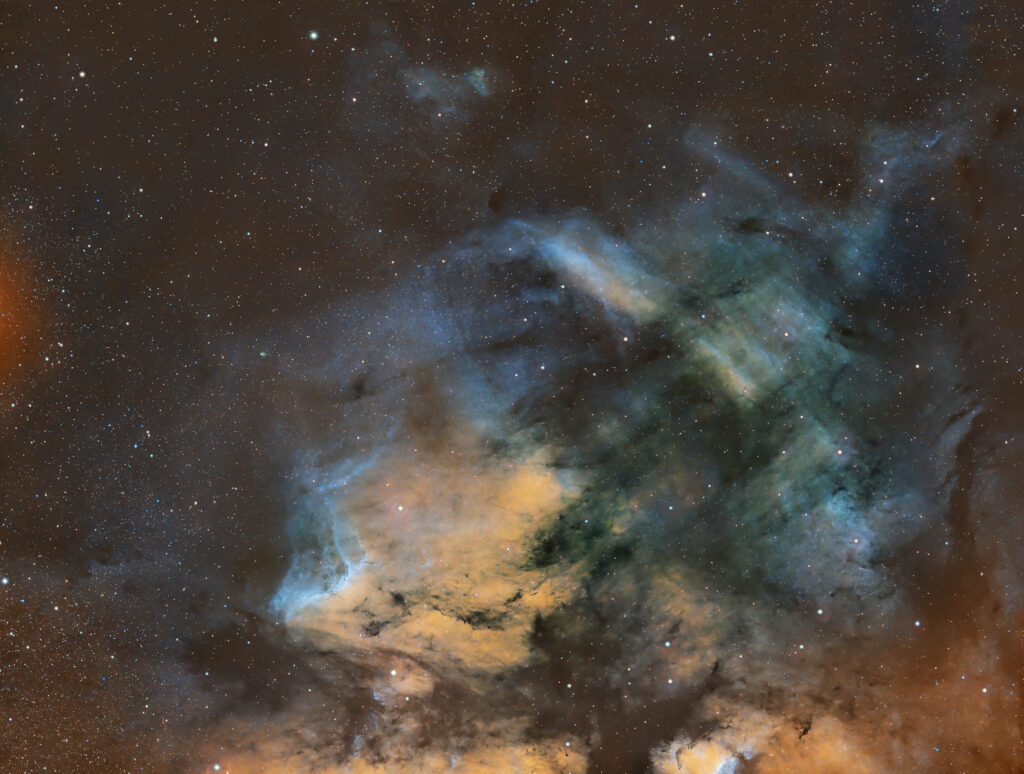
HIP102483 Cygnus region in narrowband, SHO and Hbeta channels.
This is the first of a couple of panel mosaic of narrowband recording focused about NGC7000 region in Cygnus; subframes of 180sec at -20C taken between 28/05/2023 and 22/08/2023 with ASI1600mm Pro under William Optics Redcat 51, mont EQM35 Pro.
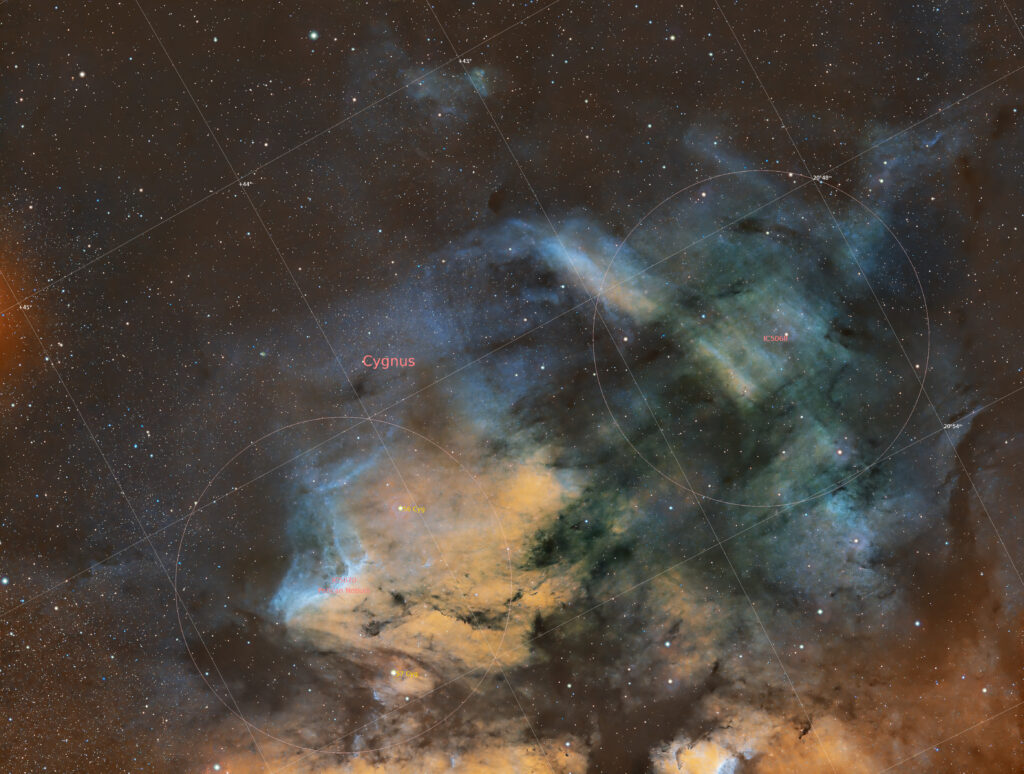
SHO classic palette integration, with annotations
Ha Oiii and Hbeta palette integration
My preferred integration, with Sii for red channel, Ha for green and Oiii + Hbeta for blue.
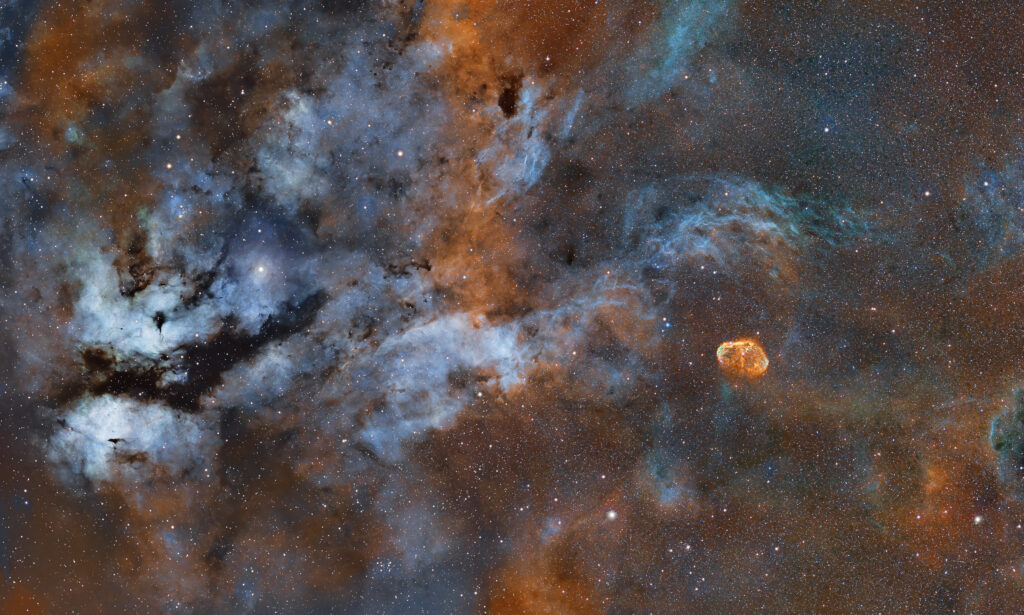
2 plates mosaic for this region of Cygnus.
Hbeta narrowband channel I used to integrate Oiii data.
Astrobin: https://www.astrobin.com/h4nkm8/B/
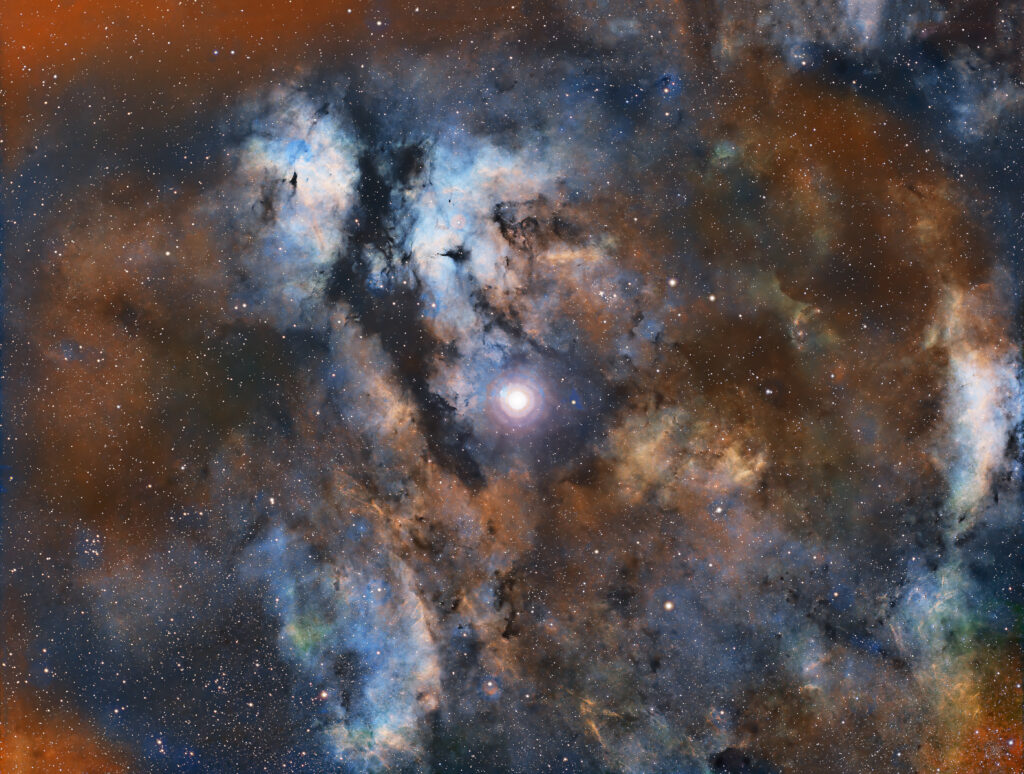
Astrobin: https://www.astrobin.com/z4lriv/E/
Pose:
Astronomik H-alpha CCD 6nm: 405×180,″(20h 15′) (gain: 173.00) -20°C bin 1×1
Astronomik OIII CCD 6nm: 270×180,″(13h 30′) (gain: 173.00) -20°C bin 1×1
Astronomik SII CCD 6nm: 316×180,″(15h 48′) (gain: 173.00) -20°C bin 1×1
Optolong H-beta 25nm 1.25″: 180×180,″(9h) (gain: 173.00) -20°C bin 1×1
Integrazione:58h 33′
Giorno lunare medio:13.70 giorni
Fase lunare media:53.65%
Scala del Cielo Scuro Bortle:6.00
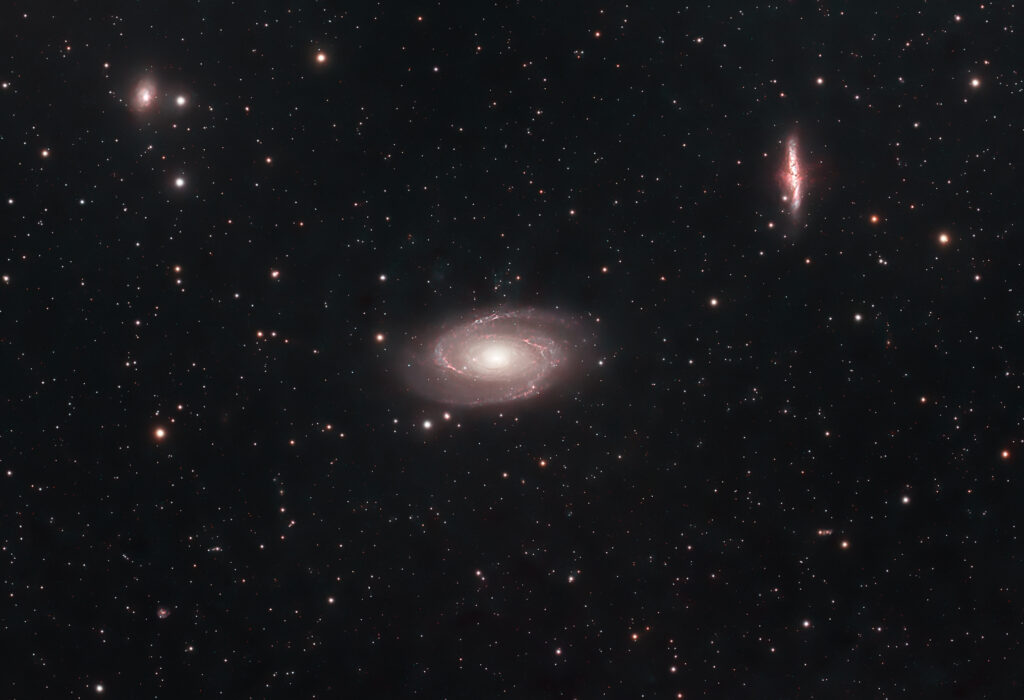
Astrobin:
During 2021 and 2022 I took a good number of subframes focusing on M81 and M82 field and I planned to integrate RGB channels with Ha and Oiii narrowband contribute.
Being a follower of John Rista short time DSO photography approach, RGB channel subframes I recorded at 60″, Halpha and Oiii subframes at 180″, William Optics Redcat51 and ASI1600mm Pro at -20 Celsius, Gain 139.
For Rista excellent studies, please cfr. https://jonrista.com/the-astrophotographers-guide/the-zwo-asi1600-guide/the-zwo-asi1600/preliminary-analysis/ and https://www.cloudynights.com/topic/578198-short-exposure-time-asi-1600mm-cool/ both on 02/08/2023.
After standard calibration, cosmetic correction by dark-master, star registration and winsorized sigma clipping integration, I obtained masterframe for each channel recorded.
Channel combination of RGB generated a good integration which I played with Ha and Oiii masters to Dynamic BG removal, solving (and annotated transparent layer version for further work), Spectrophotometric Color Calibration (just RGB) deconvolution and denoising.
I then proceed by starXterminator in starless and stars version of each master to work properly ‘till putting them back by PixelMath, obtaining a pretty good RGB master
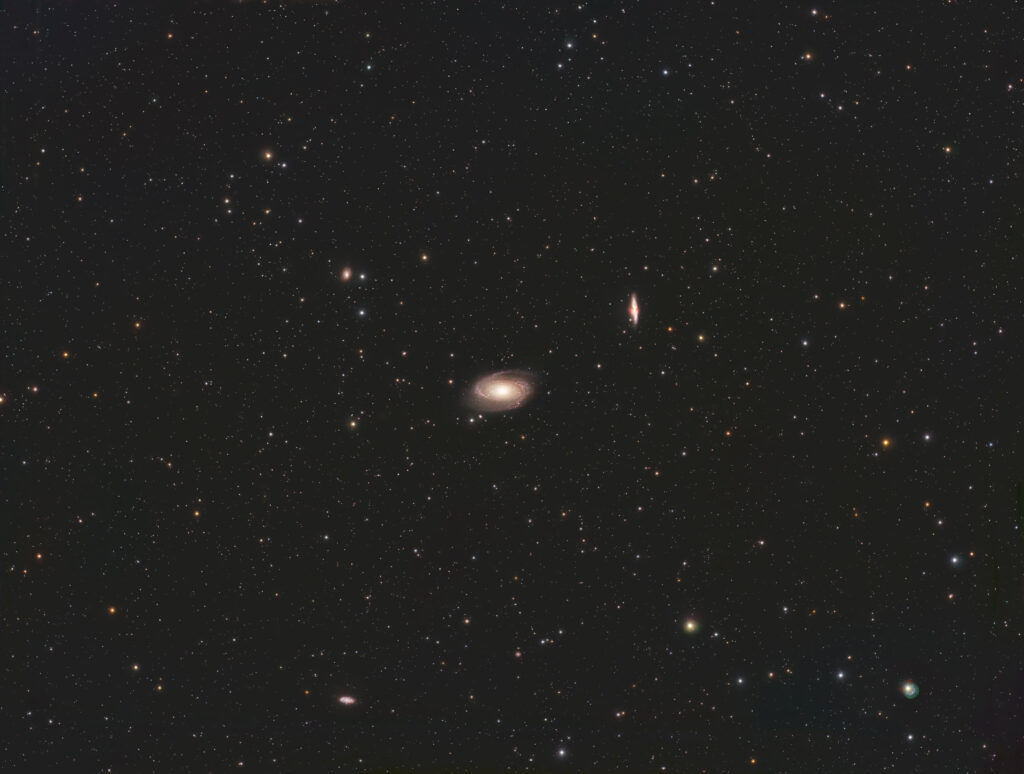
with ready-to-go Halpha and Oiii narrowband master to integrate within:
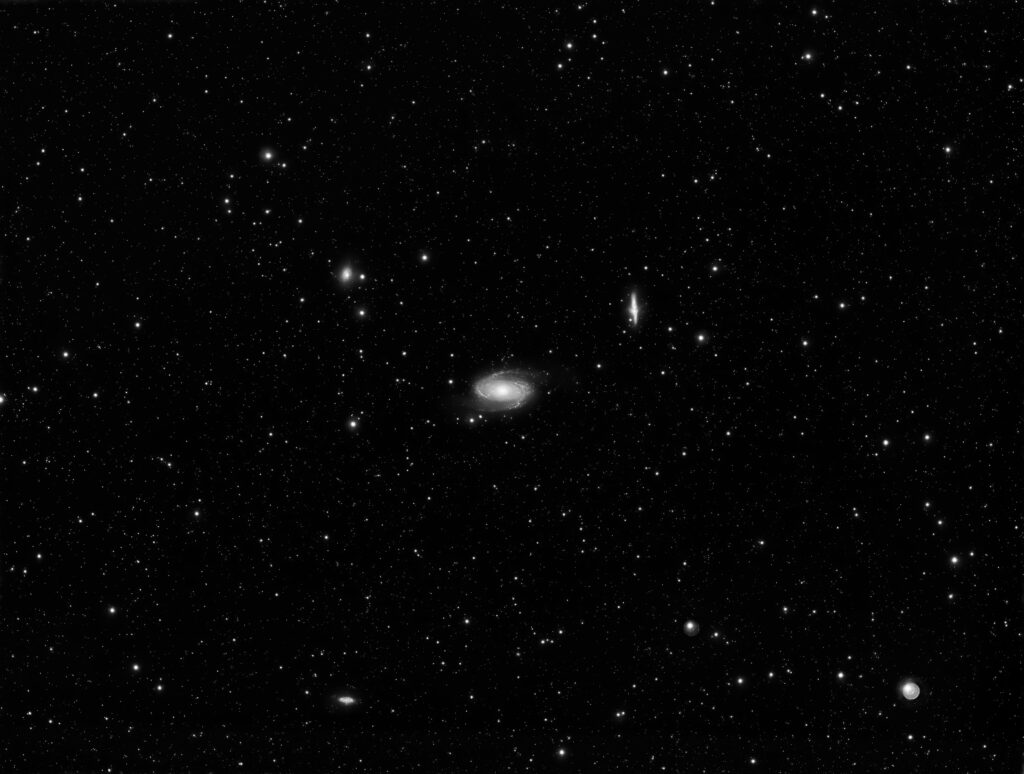
H alpha channel to be associated to R channel while Oiii to differently be integrated with both G and B channels.
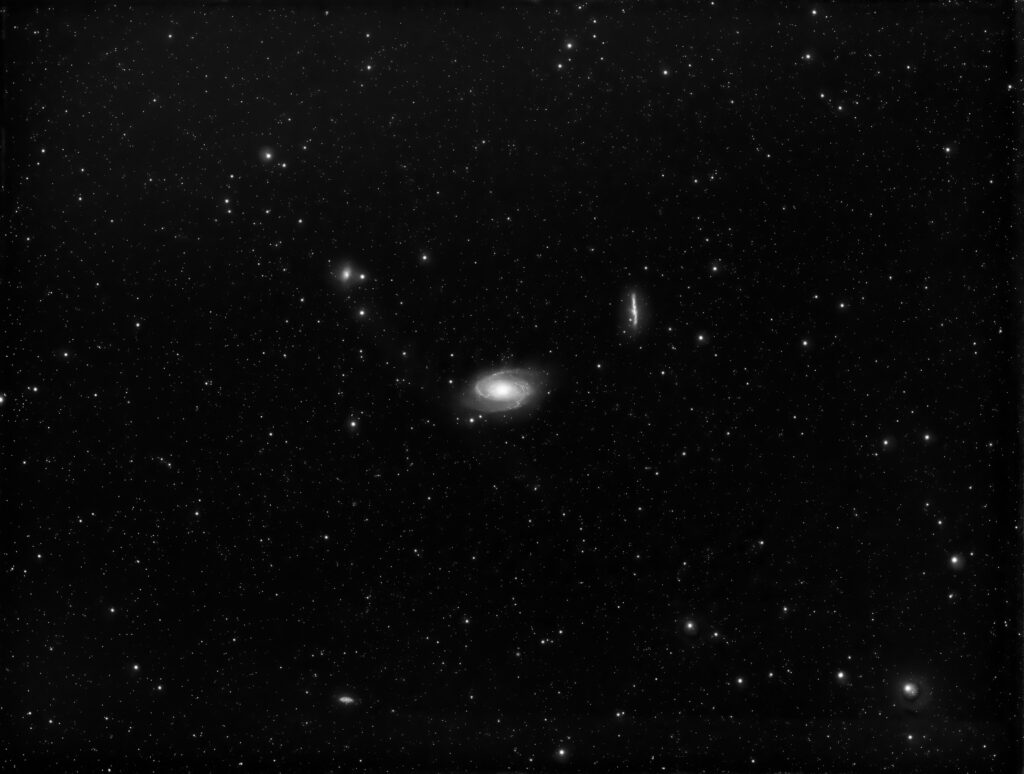
Narrowband with RGB integration produced a pretty good result which, in turns, I little worked over separating again stars and starless sub-master, finally directly melted in Photoshop.
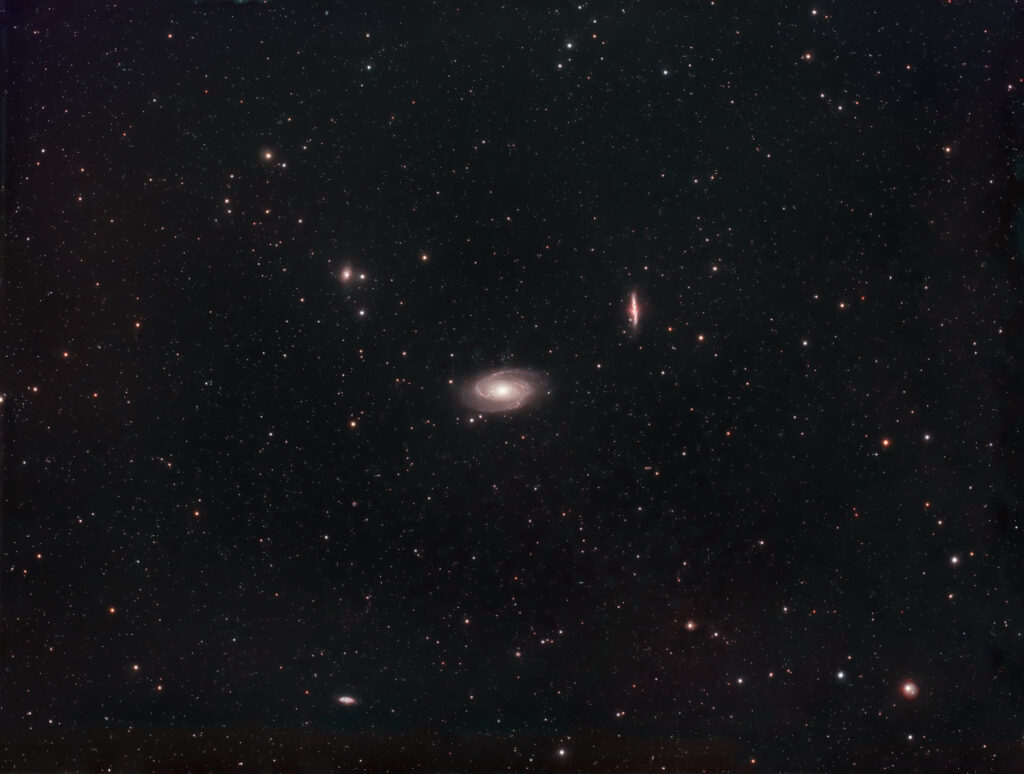
This portion of sky is so rich of galaxies; PGC annotation (PixInSight) gives an idea of the richness of field
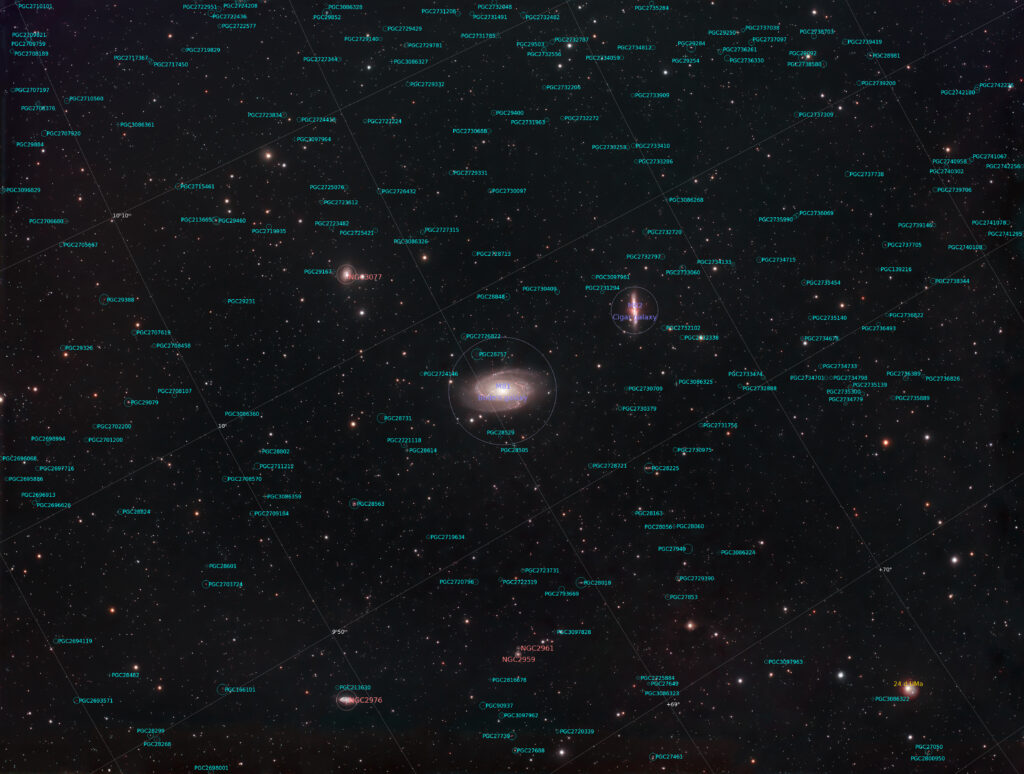
I thus start to try some crop solution for better framing and focusing the final image. At first I cropped a squared and a vertical version to catch in the field also NGC2976, NGC2961 and NGC2959.
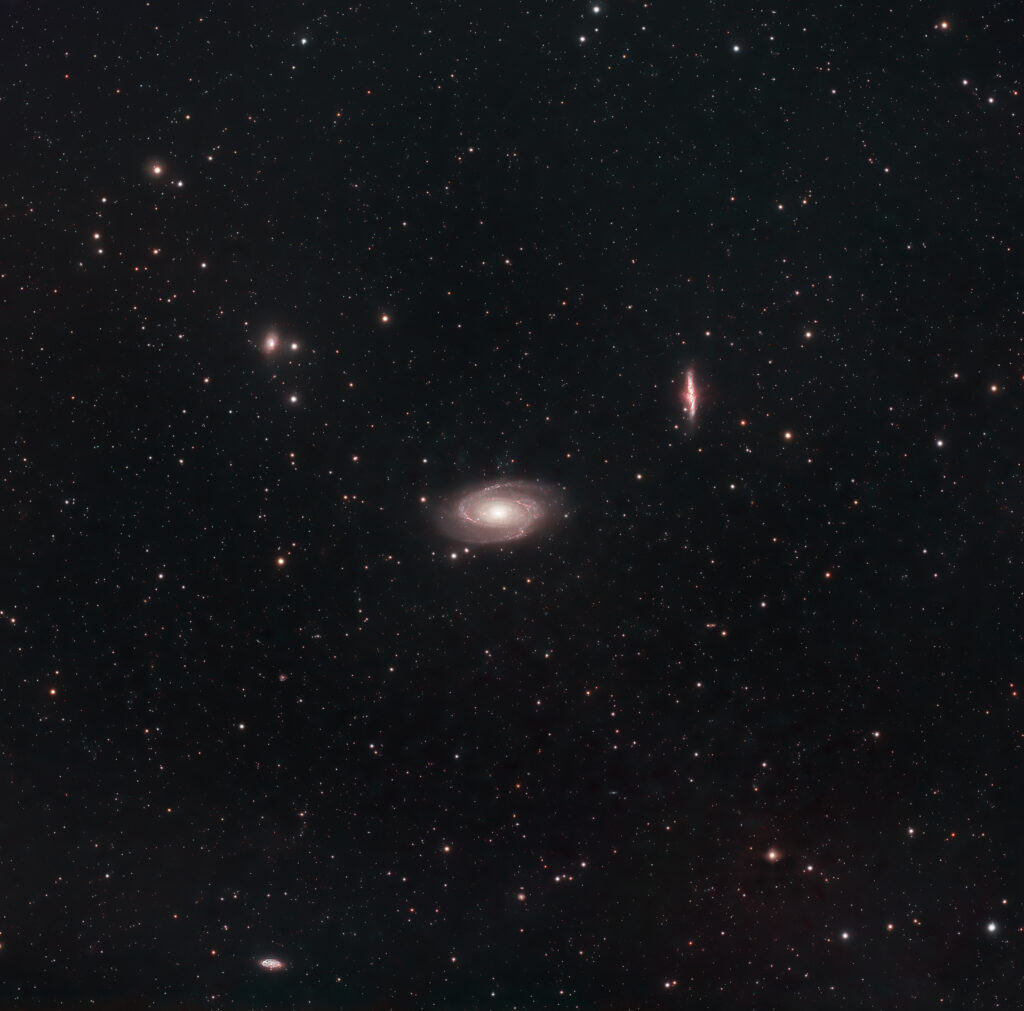
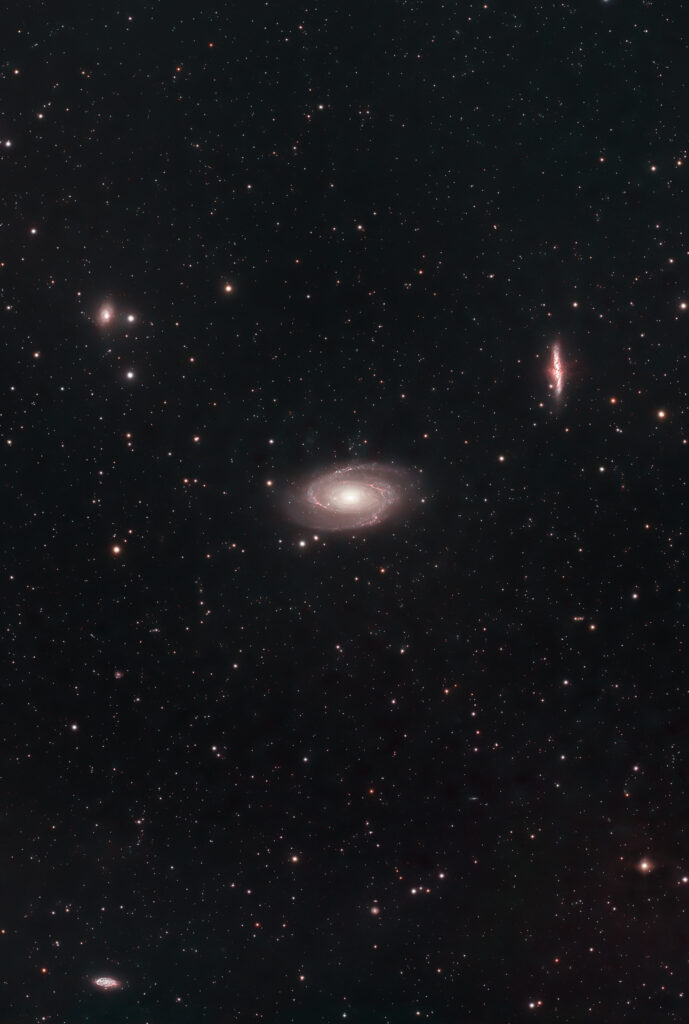
Finally I focused about M81 and M82 with a deep cropping for an orizontal composition, trying to dispose M81 and friends according to 3/4 grids basic composition rule.
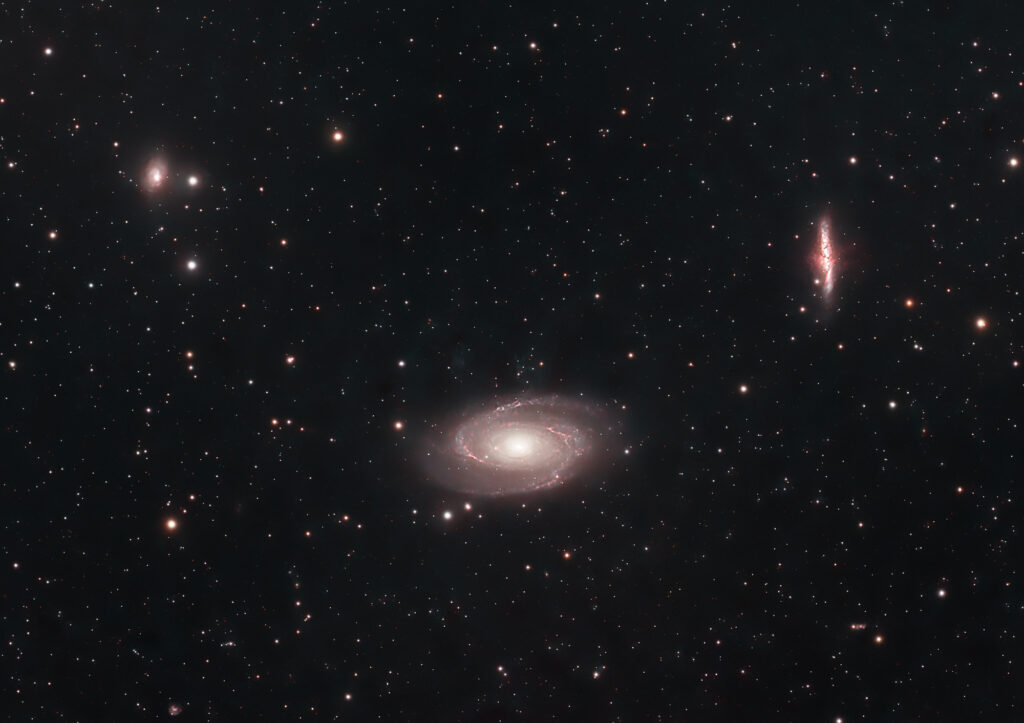
Photoshop, non cropped version, with 3 main crops framing as guide layer are available here

According to Stewart Sharpless annotation, 1959 “A Catalogue of Hii Regions” U.S. Naval Observatory, 10 Sept. 1959 [ https://articles.adsabs.harvard.edu/pdf/1959ApJS….4..257S ], Sh2-139 is “Part of II Cep association” a wide and luminous OB spectral type stellar association situated at a distance of about 3.200 parsec, or 10.400 light years, within the Perseus Arm, one of the 2 major spiral arms of our galaxy.
Cfr.: Churchwell Ed, Babler Brian L., Meade Marlin A. 2009 “The Spitzer/GLIMPSE Surveys: A New View of the Milky Way” Publications of the Astronomical Society of the Pacific. 121: 213–230. https://ui.adsabs.harvard.edu/abs/2009PASP..121..213C/abstract
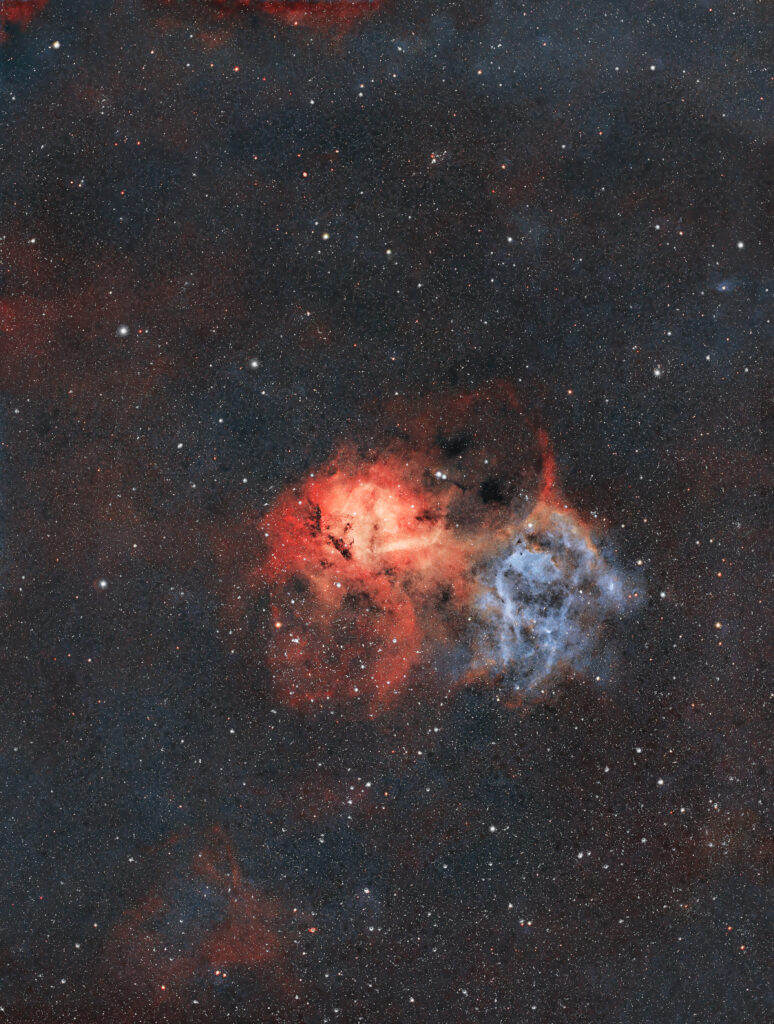
Sh2-132 complex is featured by a bright optical nebula with an intense central region (Ø = 25’) surrounded by more diffuse emission ( Ø ~ 1*). Low resolution radio studies have shown it to be an intense radio source with a strong central core contained into a more diffuse envelope.
Churchwell and Walmsley 1973 analysis confined that the total emission is thermal nature, featured by a spectrum flatted down to 0.408 GHz, typical of a low Hii density region.
Cfr. Churchwell E. , Walmsley C. M. , 1973 “Observation of Optical Nebula at 2695 Mhz ” in Astron. Astrophys. 23: 117
Nebula analysis shows two distinct regions separated by an area, running from NW to SE, with little or no emission.
The optical emission in the eastern region is quite mottled, with areas of bright emission and patches of obscuring materials. Western region is instead featured by little or no obscuring matter.
According to Lynds 1962 Catalogue of Dark Nebulae there are three main dark nebulae classified as LDN 1150, LDN 1154 and LDN 1162; Cfr. https://heasarc.gsfc.nasa.gov/W3Browse/nebula-catalog/ldn.html
Strong central features and western/eastern regions strong/weaker emission are confirmed by radio analysis at 0.408 GHz and 1.4 GHz conducted respectively by Felli et al. 1977a and Felli and Churchwell 1972.
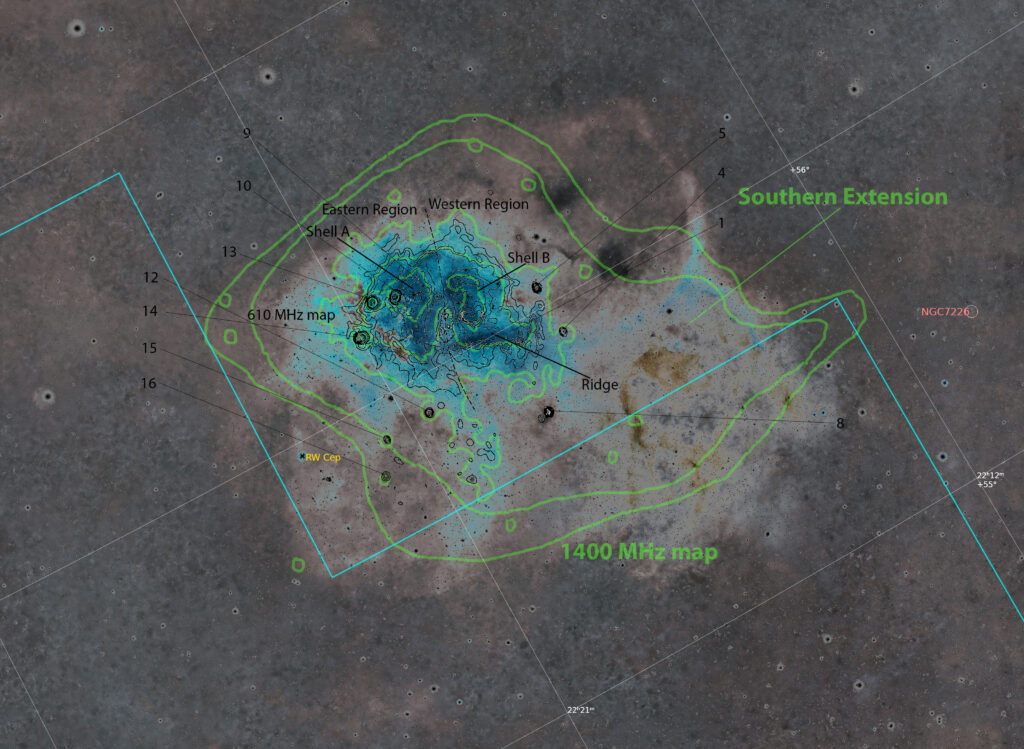
According to Van der Hucht 2001 and Hamman et al. 2006 among those very hot and massive stars responsible for the ionization of gasses, notable consideration have to be taken about two Wolf-Rayet subjects, known as HD 211564 and HD 211853 (or WR 153), featured by a huge bubble well visible in radio emissions identified as Shell B, which scholars suggest to be originated from strong stellar wind from these massive star, featured after Harten et al. 1978 study by a non uniform emission specially on the eastern side where there is essentially no emission at all.
Similar smaller structure, named Shell A, bubbles around a class K star.
Cfr. Van der Hucht K. A. , 2001 “VizieR Online Data Catalog: 7th Catalog of Galactic Wolf-Rayet stars” in NewAR,45, 135. https://ui.adsabs.harvard.edu/abs/2001yCat.3215….0V/abstract
Hamann W. R., Gräfener G. , Liermann A. , 2006 A&A,70, 205. https://ui.adsabs.harvard.edu/abs/2006A%26A…457.1015H/abstract
According to Dubout-Crillon 1976 catalogue, lion’s bottom and tail shaped like portion is made by a thin strip of emission extending to the south of the eastern region featured by a faint Halpha ridge.
Cfr. Dubout-Crillon R. 1976 “H II regions of the northern Milky Way: medium-large-field photographic atlas and catalogue” in Astronomy and Astrophysics, Suppl. Ser., Vol. 25, p. 25 – 54. https://adsabs.harvard.edu/full/1976A%26AS…25…25D
According to Avedisova 2002 it is plausible to hypothesize that this nebula was setting of some chain processes of star origin.
Avedisova, V. S., A Catalog of Star-Forming Regions in the Galaxy, in Astronomy Reports, vol. 46, n. 3, marzo 2002, pp. 193-205. https://ui.adsabs.harvard.edu/abs/2002ARep…46..193A/abstract
Harten et al. 1978 studies of radio emission of this Hii region results indicated that 2/3 of the radio emissions originates in features larger then 10’ in diameter, suggesting that total mass and low electron density placed Sh2-132 as a member of evolved giant Hii region.
Helou and Walker studies of infrared sources identified and cataloged within the nebula nine sources of infrared radiation, while Wouterloot and colleagues 2013 identified an H2O maser source.
Helou, George; Walker, D. W., Infrared astronomical satellite (IRAS) catalogs and atlases. Volume 7: The small scale structure catalog, in Infrared astronomical satellite (IRAS) catalogs and atlases, vol. 7, 1988, pp. 1-265. https://ui.adsabs.harvard.edu/abs/1988iras….7…..H/abstract
Wouterloot, J. G. A.; Brand, J.; Fiegle, K., IRAS sources beyond the solar circle. III – Observations of H2O, OH, CH3OH and CO, in Astronomy and Astrophysics Supplement Series, vol. 98, n. 3, maggio 1993, pp. 589-636. URL consultato il 21 marzo 2013. https://ui.adsabs.harvard.edu/abs/1993A%26AS…98..589W/abstract
The development of infrared astronomy gives chances to scholars like Saurin and colleagues 2009 to explore Sh2-132 Hii regions and studied its Hii region as a star forming region and embedded star clusters complex.
Grounding on Harten et al. 1978 radio continuum emission as indication of giant nature of this complex and its evolved character, Saurin hypothesized that Sh-132 could be suitable laboratory for early dynamical and hydrodynamical evolution, and by R-band Digitalized Sky Survey imaging of the whole complex they confirm 2 previous identified open cluster

And discovered 4 new open cluster:
Cfr. Saurin T. A. , Bica E. , Bonatto C. , 2010 “Star clusters in the Sh2-132 complex: clues about the connection between embedded and open clusters” in journal of Royal Astronomical Society, 407, 133-143 (2010) https://academic.oup.com/mnras/article-pdf/407/1/133/3067396/mnras0407-0133.pdf